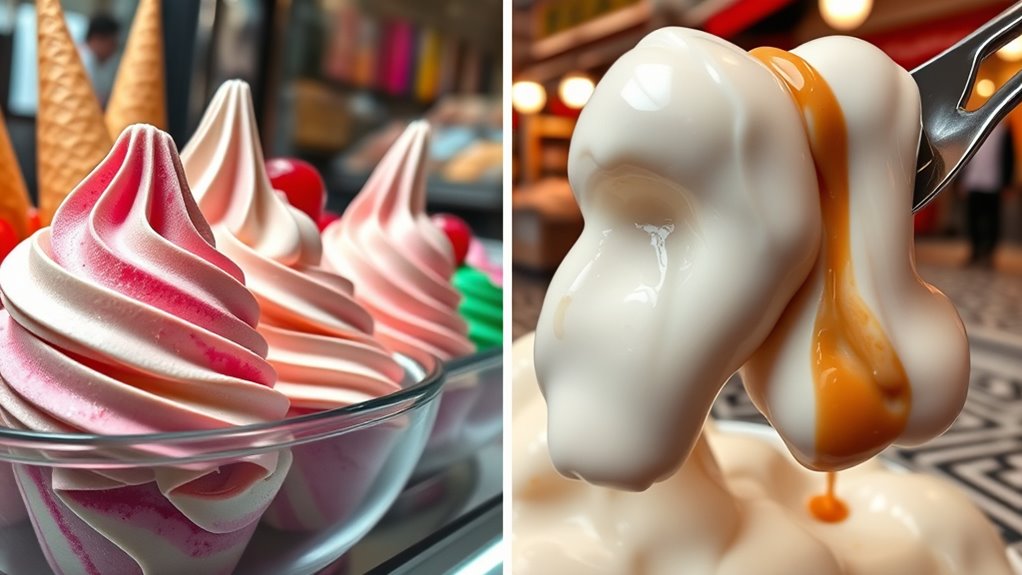Italian gelato and Turkish dondurma differ mainly in texture, flavor, and cultural roots. Gelato is smooth, dense, and creamy, focusing on natural ingredients and refined flavors, reflecting Italy’s artistic culinary tradition. Dondurma, on the other hand, is chewy, elastic, and slightly stretchy, emphasizing craftsmanship and entertainment rooted in Turkish culture. Discover how these unique treats embody their rich histories and traditions as you explore their fascinating differences further.
Key Takeaways
- Gelato has a smooth, dense texture with less air, emphasizing rich, natural Italian flavors, while Dondurma is chewy, elastic, and playful.
- Gelato originates from Italy’s Renaissance, focusing on artisanal refinement; Dondurma is rooted in Turkish tradition, highlighting craftsmanship and social interaction.
- Gelato uses slow churning and high-quality ingredients for flavor purity; Dondurma combines salep and mastic for its unique stretchy consistency.
- The Italian gelato emphasizes flavor harmony and natural ingredients; Turkish Dondurma prioritizes texture, entertainment, and cultural storytelling.
- Gelato offers a creamy, indulgent experience reflecting Italian artistic heritage; Dondurma provides a playful, elastic experience embodying Turkish customs.

Have you ever wondered what sets Italian gelato apart from Turkish dondurma? At first glance, both are delicious frozen treats, but their differences run deep, especially when you consider their texture contrast and cultural origins. Understanding these elements helps you appreciate why each has its unique appeal and how they reflect the traditions behind them.
Italian gelato is renowned for its smooth, velvety texture, which results from its rich ingredients and slow churning process. Unlike traditional ice cream, gelato contains less air, making it denser and creamier. This texture contrast is what makes every spoonful so indulgent. Its cultural origins trace back to the Renaissance period in Italy, where artisans perfected their craft by blending local ingredients like fresh fruit, nuts, and dairy. The focus on quality and simplicity allows gelato to highlight the natural flavors of its components, creating a harmonious balance that’s both revitalizing and satisfying.
On the other hand, Turkish dondurma boasts a distinctly different texture, one that’s elastic, chewy, and even slightly stretchy. This unique consistency comes from the use of salep, a flour made from wild orchid tubers, and mastic, a resin that gives it its chewiness. The texture contrast in dondurma isn’t just a culinary trick; it’s a reflection of Turkish cultural origins rooted in centuries of tradition. Dondurma is often served with theatrical flair, with vendors stretching and twirling it to entertain customers. Its chewy nature allows it to be manipulated and shaped, which is a hallmark of Turkish street food culture. The process of making dondurma emphasizes not only taste but also craftsmanship, highlighting the importance of social interaction and entertainment in Turkish culinary practices.
While gelato emphasizes purity of flavor and smoothness, dondurma’s appeal lies in its playful, elastic consistency and the cultural story it tells. Both treats showcase the diversity of ice cream traditions around the world, yet their core differences in texture contrast and origins embody the distinct histories and lifestyles they emerge from. When you indulge in gelato, you’re experiencing a slice of Italian artistic heritage, focused on refinement and flavor harmony. Sampling dondurma, meanwhile, immerses you in Turkish culture’s emphasis on community, entertainment, and tradition. Each offers a unique sensory experience rooted in centuries of cultural development, making them more than just frozen desserts—they’re edible expressions of history and identity. Additionally, the traditional preparation methods of each treat further emphasize their cultural significance and craftsmanship.
Frequently Asked Questions
Which Country Produces More Ice Cream Annually?
You’ll find that the United States produces more ice cream annually than Italy or Turkey. The US’s ice cream industry is massive, with a high demand for various flavors and styles. Its annual production surpasses both countries, thanks to a large population and a strong tradition of ice cream consumption. So, if you’re curious about global output, the US leads in the total volume of ice cream produced each year.
Are There Any Health Benefits Specific to Gelato or Dondurma?
You’ll find that gelato offers nutritional advantages like lower fat content, which can support your digestive health better than some other ice creams. Dondurma, on the other hand, contains natural ingredients like mastic, which may have anti-inflammatory properties. Both can be enjoyed in moderation, but gelato’s lighter ingredients might give you a slight edge for maintaining better digestive health and overall wellness.
Can You Find Authentic Dondurma Outside Turkey?
Authentic dondurma outside Turkey exists, but finding it can be tricky. While some specialty stores and Turkish markets import it, strict Dondurma import regulations often limit availability. You’ll notice the chewy texture and unique flavor, just like in Turkey. To enjoy genuine dondurma, seek out trusted Turkish vendors or restaurants that prioritize authentic imports, ensuring you get the true experience despite the challenges posed by import restrictions.
What Are the Traditional Serving Customs for Each Ice Cream?
You’ll find that serving rituals and cultural etiquette shape how each ice cream is enjoyed. For gelato, it’s common to see it served in small, elegant cups or cones, emphasizing presentation and moderation. Dondurma, however, is often served with playful interaction—vendors might stretch it or perform tricks, showcasing cultural hospitality. Respect these customs by appreciating the traditions, whether it’s savoring gelato slowly or engaging with a friendly dondurma vendor.
How Do Storage Requirements Differ for Gelato and Dondurma?
You should store gelato and dondurma differently to maintain their ideal textures. Gelato needs airtight storage containers and consistent freezing temperatures just below freezing point, preventing ice crystals. Dondurma, on the other hand, benefits from being kept in sealed containers at slightly higher temperatures to preserve its chewy, elastic texture. Both require proper freezing, but tailoring storage conditions guarantees each ice cream retains its unique qualities.
Conclusion
So, as you savor a scoop of gelato or dondurma, remember that you’re tasting more than just dessert—you’re experiencing centuries of tradition and culture. Like the legendary tales of Homer’s heroes or the timeless stories of Scheherazade, these frozen treats carry stories of passion, craftsmanship, and history. Whether you prefer Italy’s silky gelato or Turkey’s stretchy dondurma, you’re partaking in a delicious journey that bridges worlds and awakens your senses.









